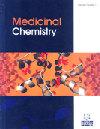取代的 4H-3,1-苯并恶嗪-4-酮衍生物作为凝血酶 G 的抑制剂
IF 1.9
4区 医学
Q3 CHEMISTRY, MEDICINAL
引用次数: 0
摘要
背景:Cathepsin G(CatG)是一种阳离子丝氨酸蛋白酶,具有广泛的底物特异性。据报道,CatG 在多种病症中发挥作用,包括类风湿性关节炎、缺血再灌注损伤、急性呼吸窘迫综合征和囊性纤维化等。我们的目标是我们旨在开发一类新的 CatG 抑制剂,并评估它们对一系列丝氨酸蛋白酶的效力和选择性。研究方法我们利用化学合成和显色底物水解试验来构建和评估新的抑制剂。结果:在这篇通讯中,我们报告了一类新的 4H-3,1-苯并恶嗪-4-酮衍生物 CatG 抑制剂。我们构建了一个由 7 种取代的 4H-3,1-苯并恶嗪-4-酮衍生物组成的小型文库,并鉴定了它们对 CatG 的抑制潜力。其中五个分子被鉴定为 CatG 抑制剂,其抑制值为 0.84-5.5 μM。其中,抑制剂 2 的作用最强,其 IC50 值为 0.84 ± 0.11 μM,对凝血酶、XIa 因子、XIIIa 因子和 Kallikrein 等代表性丝氨酸蛋白酶具有显著的选择性。结论:因此,我们建议将这种抑制剂作为先导分子,以指导后续开发临床相关的强效、选择性 CatG 抑制剂作为抗炎药物的工作。本文章由计算机程序翻译,如有差异,请以英文原文为准。
Substituted 4H-3,1-benzoxazine-4-one Derivatives as Inhibitors of Cathepsin G
Background: Cathepsin G (CatG) is a cationic serine protease with a wide substrate specificity. CatG has been reported to play a role in several pathologies, including rheumatoid arthritis, ischemic reperfusion injury, acute respiratory distress syndrome, and cystic fibrosis, among others. Objective: We aim to develop a new class of CatG inhibitors and evaluate their potency and selectivity against a series of serine proteases. Methods: We exploited chemical synthesis as well as chromogenic substrate hydrolysis assays to construct and evaluate the new inhibitors. Results: In this communication, we report on a new class of CatG inhibitors of 4H-3,1-benzoxazin- 4-one derivatives. We constructed a small library of seven substituted 4H-3,1-benzoxazin-4-one derivatives and identified their inhibition potential against CatG. Five molecules were identified as CatG inhibitors with values of 0.84-5.5 μM. Inhibitor 2 was the most potent, with an IC50 of 0.84 ± 0.11 μM and significant selectivity over representative serine proteases of thrombin, factor XIa, factor XIIIa, and kallikrein. Conclusion: Thus, we propose this inhibitor as a lead molecule to guide subsequent efforts to develop clinically relevant potent and selective CatG inhibitors for use as anti-inflammatory agents.
求助全文
通过发布文献求助,成功后即可免费获取论文全文。
去求助
来源期刊

Medicinal Chemistry
医学-医药化学
CiteScore
4.30
自引率
4.30%
发文量
109
审稿时长
12 months
期刊介绍:
Aims & Scope
Medicinal Chemistry a peer-reviewed journal, aims to cover all the latest outstanding developments in medicinal chemistry and rational drug design. The journal publishes original research, mini-review articles and guest edited thematic issues covering recent research and developments in the field. Articles are published rapidly by taking full advantage of Internet technology for both the submission and peer review of manuscripts. Medicinal Chemistry is an essential journal for all involved in drug design and discovery.
 求助内容:
求助内容: 应助结果提醒方式:
应助结果提醒方式:


